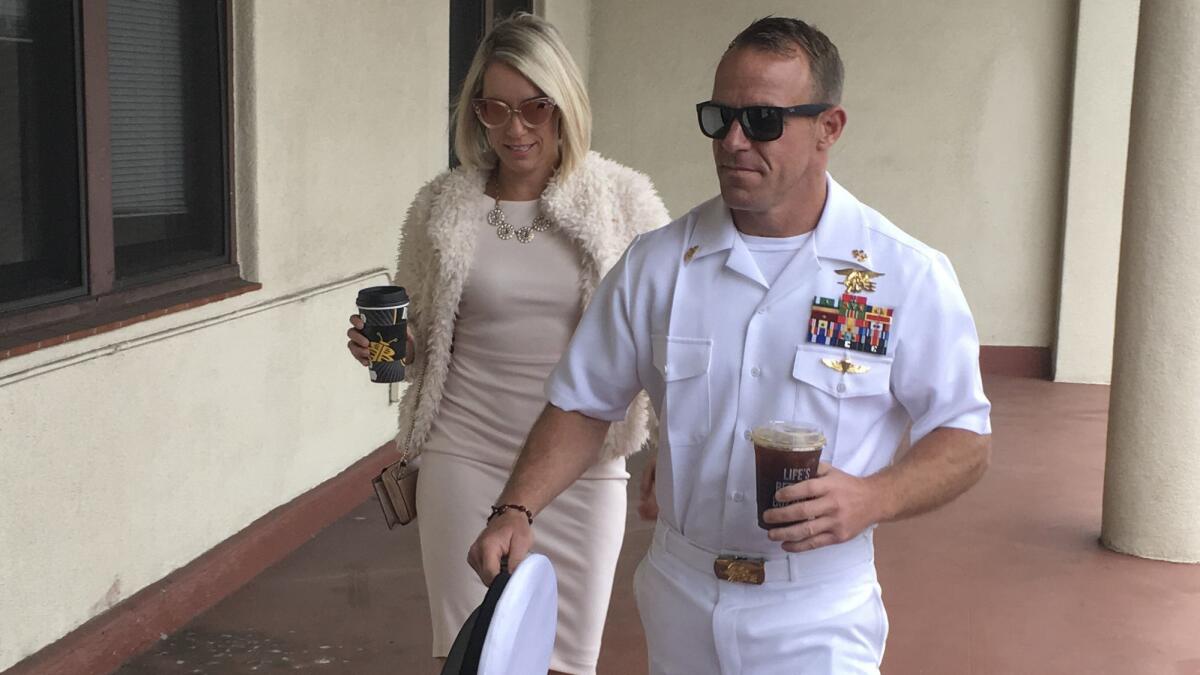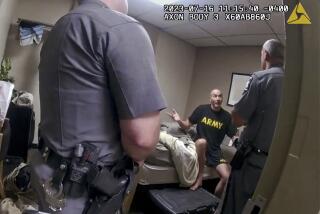Navy SEAL murder trial: Stabbing could have killed prisoner, doctor testifies

- Share via
Reporting from san diego — A pathologist testified Monday at a Navy SEAL’s murder trial that a wounded Islamic State militant in Iraq could have died from a stabbing described by other witnesses.
Dr. Frank Sheridan said he couldn’t determine a cause of death because of a lack of evidence. There was no body, no photos of a knife wound, and photos and video shot only by other SEALs, not investigators.
His testimony at the trial of Special Operations Chief Edward Gallagher, though, countered a statement offered last week by another SEAL who stunned the court when he confessed to the killing.
Corey Scott testified Thursday that he killed the victim by plugging his breathing tube after Gallagher unexpectedly stabbed the fighter while treating him for injuries suffered in an airstrike outside Mosul in 2017.
Scott testified that the militant, described as an adolescent boy, would have survived the stabbing. Scott previously told investigators that there was nothing he could do to save the boy’s life.
On the witness stand, Scott said he decided to asphyxiate the captive because he assumed he would be tortured and killed by Iraqi forces who captured him and brought him to Navy medics for treatment.
Gallagher, 40, is charged with murder in the killing of the boy and attempted murder for allegedly gunning down civilians from his sniper’s post.
He has pleaded not guilty. His lawyers blame his former troop mates of fabricating the accusations to get Gallagher ousted from the special forces because they didn’t like his tough leadership.
The defense also said Gallagher was treated unfairly by investigators and prosecutors — a point they tried to make to the jury Monday during cross-examination of a Naval Criminal Investigative Service agent.
Two of Gallagher’s sons — ages 8 and 18 — were home during a search conducted by officers armed with rifles, Special Agent Brian Frank acknowledged.
“They were taken out of the house in their underwear with M-4s pointed at them?” defense attorney Tim Parlatore said.
“That’s correct,” said Frank, noting it was standard procedure.
Phones belonging to the children as well as two other phones were seized, Frank said.
Dozens of congressional Republicans have voiced support for Gallagher and brought his case to President Trump’s attention.
Trump had Gallagher moved from the brig to better confinement conditions at a Navy hospital and is reportedly considering a pardon for the decorated sailor.
Scott and another SEAL said last week that Gallagher had initiated medical treatment for the boy and then stabbed him in the neck area for no apparent reason.
NCIS Special Agent Joseph Warpinski testified Monday that Scott told him Gallagher stabbed the boy multiple times.
Gallagher later texted a photo of the corpse to friends with the following message: “Good story behind this, got him with my hunting knife.”
His lawyers said the message was an attempt at dark humor.
The pathologist had only witness accounts and photos and video of the wounded war prisoner to base his testimony.
After the boy was wounded in an airstrike — more than an hour before being brought to U.S. forces for treatment — he was interviewed by an Iraqi TV news crew. He appeared lucid and did not have significant hemorrhaging, though his breathing was labored, the doctor said.
“He’s clearly responsive,” Sheridan said.
Sheridan said it appeared that the medical procedures were intended to save the patient’s life.
Witnesses at the scene said Gallagher treated the boy for a leg wound and an apparent case of blast lung from the concussion of the airstrike. The patient was sedated and given a breathing tube.
He was breathing normally after the procedure when Gallagher suddenly pulled out his personal knife and stabbed him, witnesses said.
A fixed-blade knife with a distinct black and tan wooden handle that matched the weapon described by witnesses was shown to the jury and identified by NCIS Special Agent Chris Leiphart as being seized from Gallagher’s belongings.
Depending on the location of the stab wounds, the captive could have died from profuse internal or external bleeding, Sheridan said. But he couldn’t make that determination.
“I can’t give an opinion on the cause of death,” Sheridan said. “There just isn’t enough evidence.”
More to Read
Sign up for Essential California
The most important California stories and recommendations in your inbox every morning.
You may occasionally receive promotional content from the Los Angeles Times.













